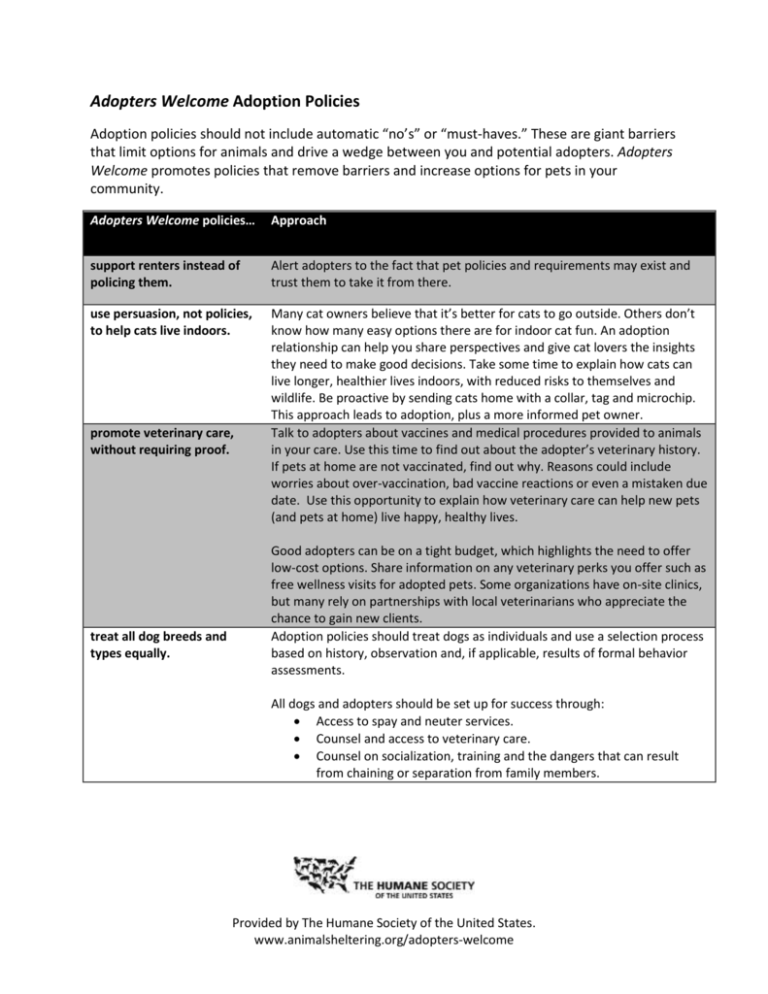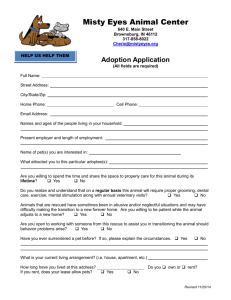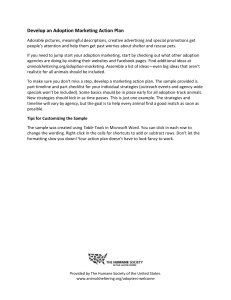Adopters Welcome: Policies
advertisement

Adopters Welcome Adoption Policies Adoption policies should not include automatic “no’s” or “must-haves.” These are giant barriers that limit options for animals and drive a wedge between you and potential adopters. Adopters Welcome promotes policies that remove barriers and increase options for pets in your community. Adopters Welcome policies… Approach support renters instead of policing them. Alert adopters to the fact that pet policies and requirements may exist and trust them to take it from there. use persuasion, not policies, to help cats live indoors. Many cat owners believe that it’s better for cats to go outside. Others don’t know how many easy options there are for indoor cat fun. An adoption relationship can help you share perspectives and give cat lovers the insights they need to make good decisions. Take some time to explain how cats can live longer, healthier lives indoors, with reduced risks to themselves and wildlife. Be proactive by sending cats home with a collar, tag and microchip. This approach leads to adoption, plus a more informed pet owner. Talk to adopters about vaccines and medical procedures provided to animals in your care. Use this time to find out about the adopter’s veterinary history. If pets at home are not vaccinated, find out why. Reasons could include worries about over-vaccination, bad vaccine reactions or even a mistaken due date. Use this opportunity to explain how veterinary care can help new pets (and pets at home) live happy, healthy lives. promote veterinary care, without requiring proof. treat all dog breeds and types equally. Good adopters can be on a tight budget, which highlights the need to offer low-cost options. Share information on any veterinary perks you offer such as free wellness visits for adopted pets. Some organizations have on-site clinics, but many rely on partnerships with local veterinarians who appreciate the chance to gain new clients. Adoption policies should treat dogs as individuals and use a selection process based on history, observation and, if applicable, results of formal behavior assessments. All dogs and adopters should be set up for success through: Access to spay and neuter services. Counsel and access to veterinary care. Counsel on socialization, training and the dangers that can result from chaining or separation from family members. Provided by The Humane Society of the United States. www.animalsheltering.org/adopters-welcome Adopters Welcome policies… Approach welcome the giving of pets as gifts. We know that puppies and kittens (and older pets!) can be wonderful presents for children, loved ones and friends during the holidays and for birthdays, too. Instead of sending adopters to pet stores, questionable breeders and classified ads because of unfounded fears, support these gift adoptions by helping the gift giver find the best match for their lucky recipient. Let your continued support for the pet and new guardian be a gift that keeps on giving. Unless an adopter wants help physically introducing dogs, skip this requirement. Instead, offer guidance on how to successfully and gradually introduce new pets to resident pets at home. provide tips on how to introduce a new pet, but don’t require a “meet and greet” unless the adopter requests one. allow adopters to determine if they would like all members of the home to meet a new pet before adoption. use persuasion to address declawing, not punishment. support homes long-term instead of investigating them once. help adopters keep their dogs happy and healthy, whether or not they have a fence! help pets live happily with people of all ages. It makes sense to want everyone in a household to be on the same page. It doesn’t make sense to hold up an adoption in order to prove it. Instead of forcing the issue, which wastes time and goodwill, make it a part of your adoption conversation. Some pet owners will want to take the extra time to include all members of the home in their decision, but leave that up to them. Find out why declawing is being considered and introduce adopters to effective alternatives like nail caps, scratching posts and scratching deterrents such as Sticky Paws. Have these resources available on-site to make it easier for adopters to do the right thing and remind them that you'll be available to help if problems come up at home. Let pet owners know why declawing should be a last resort. You can also encourage them to adopt cats who are already declawed. Trade the time that would otherwise be spent on home visits for helping more animals find good homes and supporting pets and families postadoption. You are far more likely to guarantee a good home when you have a close connection to adopters! What makes fences so appealing? Safety? Freedom from chains? Off-leash exercise with their family? All of these needs can be met without a fence. Instead of relying on a physical object that may not actually serve your goals, focus on the needs themselves and help adopters meet them, no matter their living environment. Share insight with adopters. If you know that the 70-pound dog is an active jumper who has a history of knocking down small children, tell adopters your concerns and ask them about their own. Together, you may be able to make these matches work, or find one that is even better. Provided by The Humane Society of the United States. www.animalsheltering.org/adopters-welcome Adopters Welcome policies… Approach support spay and neuter for pets at home, without requiring it. If pets at home are not spayed or neutered, take advantage of a great opportunity to do some outreach. Ask why. Have a conversation about the benefits of spay/neuter and take time to answer questions and concerns. Letting adopters know what options are available locally or through your organization may add spay/neuter success to your adoption success. don’t delay in sending pets home. Sending animals home at adoption requires smooth operations that start at intake. Look at your process to make sure animals have what they need to go home at adoption, including spay or neuter surgery. Anticipate bottlenecks such as weekends and holidays or increased volume for upcoming events. Make sure staff and volunteers at offsite events and satellite locations have what they need to send animals home. Many shelters are making it possible for adopters to consider stray animals before their hold is up. If these animals are not reclaimed, they can find their new homes faster. Get a head start on unavoidable delays such as post-hold spay or neuter by proactively scheduling them ahead of time. Communicating your efforts to adopters can help them manage the wait. Saying “No” Adopters Welcome is based on the knowledge that most pet relationships can be successful. However, there will be times when adoption isn’t the best option for a pet or a person, at least not right now. If you follow the philosophy and approach outlined in Adopters Welcome, you and the adopter will be more likely to come to this conclusion together. Instead of leaving you and finding a pet somewhere else, they may listen to your suggestions and come back when they are ready. Be a Resource to Pet Owners Removing barriers like phone calls to landlords and veterinarians, “must meet resident dog” requirements and home visits saves time and energy. Reinvest these resources to support adopters during and after the adoptions process. Use experience to anticipate common challenges, and then assemble resources from your organization and your community that prepare counselors to help. See animalsheltering.org/support for a template on how to assemble resources. Provided by The Humane Society of the United States. www.animalsheltering.org/adopters-welcome Return Policy The HSUS supports a no-fault return policy in which adopters are given the opportunity to find a better match, or receive a full or partial refund. This approach turns mismatches into opportunities. The former adopter can serve the same role as a foster home. By learning more about the returned animal, you can make a stronger match next time. And by embracing the “returning adopter,” you reserve a home for a different animal, either now or in the future. Rehoming Policy Remember that a major source of pets is friends and family members. Your rehoming policy should build on this success. Sometimes, in spite of efforts and desire, adoptions don’t work out. Empower adopters to follow your lead in finding a better home for the pet, without fear of breaking contracts or harming their relationship with your organization. This includes allowing them to adopt another pet from your organization. Ask the former adopter for help with encouraging the new owner to reach out to you. In addition to updating records, including contact information for microchips and ID, you can also share any follow-up assistance with them. When you are proactive about rehoming you can reserve space, time and funds for animals in greater need of assistance. Adoption Agreements and Contracts At the end of the adoption process, many shelters and rescues groups use an adoption contract to formalize the agreement between the adopting organization and the adopter. In addition to demonstrating transfer of ownership from the adopting agency to the adopter, adoption contracts also serve to protect your adoption agency from future liability. Consult with an attorney who is licensed in your state and familiar with issues pertaining to animal law when drafting or adopting legal documents such as contracts. Not only do you want to ensure that such documents are tailored to meet the requirements of all federal, state and local laws, you also want to ensure that your organization is protected in the event that there are future issues with the pet. After implementing the new approaches outlined in Adopters Welcome, examine your contract to make sure you aren’t undermining your adopter-friendly approach. For example, replace “no refunds” language and demands to return animals to your agency if they can’t be kept. Instead, focus on influencing pet care through engaging adoption conversations and follow-up support. Provided by The Humane Society of the United States. www.animalsheltering.org/adopters-welcome






